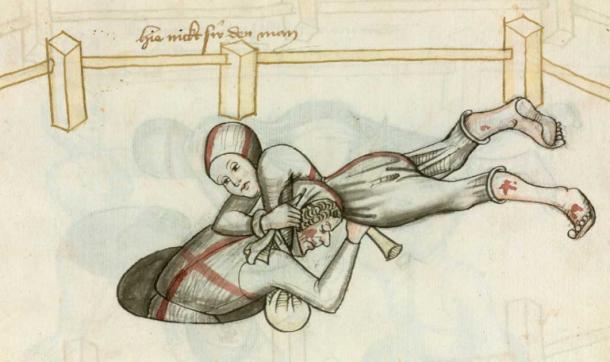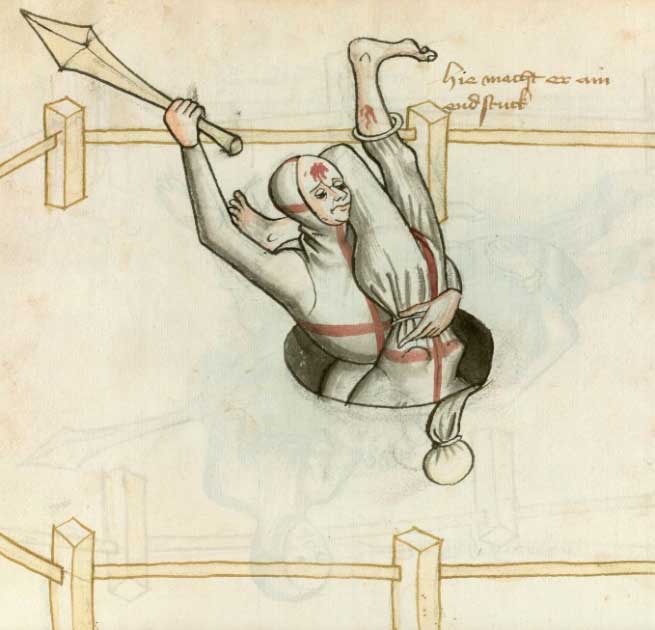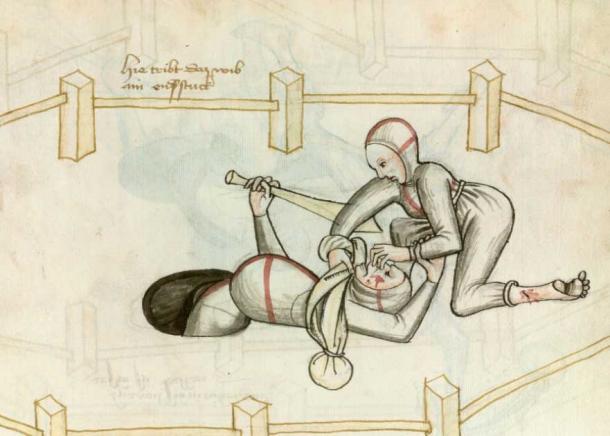
Medieval Divorce by Combat: Guaranteeing ‘til Death do us Part’
Divorce is a subject that has provided endless material for drama and comedy writers through the ages, from Euripides to Shakespeare to today’s New York Times bestseller list. When Kenneth Hodges, a Professor of English at the University of Oklahoma, discovered a medieval German manuscript laying out the rules for a “divorce by combat”, social media helped the sensational story quickly go viral. With the option of divorce by combat, divorce in medieval times could result in more than heartbreak. How common were these legally sanctioned marital duels, and how were they conducted?
- Women Scrapping with Swords and Pistols: Famous Female Duels
- The True History behind “The Last Duel” - A Tale of Trial by Combat

Divorce in medieval times could be quite violent (Spiezer Chronik, Public Domain)
The Rules of Medieval Divorce by Combat
Divorce by combat appears to have been a form of trial by combat. Trial by combat was part of Germanic law that dealt with accusations between two parties where there were no witnesses or a confession. Whoever won the duel was deemed to be right. It was essentially a legally-sanctioned duel.
These rules for a divorce by combat come from Hans Talhoffer’s Fechtbuch, which was written in 1467. The book serves as an instruction manual for how duels should be fought. The book deals with many different types of duels fought with various weapons. However, the section that caught Professor Hodges and the internet's eye was the section on duels between men and women.
The man was placed in a waist-height 3-foot (1 meter) deep hole, with one hand tied behind his back while the woman was allowed to move freely. Both parties wore practical clothes, a one-piece bodysuit with stirrup legs.

Divorce by combat had specific rules and regulations, including wearing a unitard (Public Domain)
The woman was armed with three rocks, each wrapped in a length of cloth to form a kind of swinging club. The man was given three normal clubs. His clubs matched the length of the woman’s cloth to ensure that their ranges were equal.
The man was not allowed to leave his hole. To further limit him, if he touched the edge of his hole with either his hand or arm, he had to surrender one of his clubs. If the woman attacked him while he was surrendering his club, she, in turn, forfeited one of her rocks.
The rules placed the man at a clear disadvantage, but it's important to remember that it is unlikely that the woman had had any kind of combat training. Furthermore, in any kind of physical contest, it is likely the male would have an advantage in size and strength. So the handicaps placed upon the man were to try and make the fight as fair as possible.
The conditions for victory are unclear. Some historians believe it was unlikely that fights were to the death. Instead, it was probably down to the judges to decide when one of the fighters had been incapacitated. Since both parties were hitting each other with big blunt objects, it seems likely that many trials ended with one party being knocked unconscious.
Historians have also suggested from Talhoffer’s drawings that there were alternative ways to win, such as if the woman managed to drag the man from his hole, or if he managed to drag the woman in. There is also the possibility that many of these duels eventually descended into wrestling matches, where the duels could be won by managing to pin the other party.

It is unclear how often medieval divorce by combat occurred, or how frequently it ended in death (Public Domain)
However, there is some evidence that these duels may have usually ended in a death, even if it wasn’t at the hand of the combatants. If the man lost, he would be taken from his hole and executed in the town square. If the woman lost, she would be placed in a hole and buried alive.
Talhoffer’s manual predominantly concerned itself with giving combatants fighting advice, rather than laying out the rules of a medieval divorce by combat. Other sources, including old Germanic law books, have been used to fill in the gaps.
- Caught Red-Handed! Law and Order in Medieval England
- Locked into a Relationship: The Medieval Remedy for Divorce Still Requested in Romania

Medieval sources provided strategies for divorce by combat duels (Public Domain)
Daily Divorce by Combat Duels Not Likely
The internet has taken Professor Hodge’s work and sensationalized it quite a bit. There are not many surviving sources that refer to divorce by combat. By the late medieval period, trial by combat itself was becoming increasingly uncommon, and divorces were next to impossible to get.
In addition, medieval trial by combat was predominantly used for criminal judicial purposes, not civil. Trial by combat was usually reserved for criminal cases where there was insufficient evidence, but if found guilty, the ruling would be death.
It has been proposed that this form of trial by combat between a woman and a man had a much more unpleasant purpose. In cases where a woman accused a man of rape, but had no evidence or witnesses, it is possible trial by combat was used to decide guilt.
Christians of the period believed that the victor of trial by combat was ordained by God, who would obviously favor the innocent. If the man lost to a woman, he must have been guilty and deserved to die. If the woman lost, she was a liar and so deserved to die.
Men and women dueling in trial by combat was also rare because the female plaintiff was free to choose a champion to fight in her stead. Professor Hodges uses this to claim that divorce trial by combat was perhaps more common than judicial trial by combat between a man and a woman, since a married woman was less likely to have someone willing to fight on her behalf.
Conclusion
At the end of the day, it seems unlikely that divorce by combat was all that common. Trial by combat was not a frivolous duel used to settle a disagreement. It was a serious judicial matter with complicated rules and regulations. It is unlikely the church or the state would readily sanction many of these trials, for fear they would get out of hand.
On the other hand, it is clear that trial by combat between men and women, including divorce by combat, existed under extreme circumstances. The fact that rules for such duels were written down and exist to this day supports this. Furthermore, Talhoffer wouldn’t have included them in his manual if they weren’t sufficiently common to merit his advice.
However messy divorces may get, most of us would probably agree that divorce by combat is extreme. However, some do not view it that way. In 2020, a Kansas man petitioned the District Court in Shelby County to allow him to settle his divorce through trial by combat. Still, it's probably best to stick to a potentially expensive divorce and forgo bloodshed.
Top image: Image illustrating the divorce by combat rules, from a fencing manual composed in 1459 by Hans Talhoffer. Source: Public Domain
By Robbie Mitchell
References
Hodges, K. n.d. Trial by Combat between a Man and a Woman. The University of Oklahoma. Available at: http://www.aemma.org/onlineResources/trial_by_combat/combat_man_and_woman.htm
Hunt, J. 2009. Medieval Justice: Cases and Laws in France, England, and Germany, 500-1500. Jefferson.
Kirti, K. 2020. Divorce by Combat. Medium. Available at: https://medium.com/lessons-from-history/divorce-by-combat-d9309701f718
Man Requests Trial by Combat to Settle Legal Dispute with Ex-Wife. January 15, 2020. CBS News. Available at: https://www.cbsnews.com/dfw/news/man-requests-trial-by-combat-to-settle-legal-dispute-with-ex-wife/















